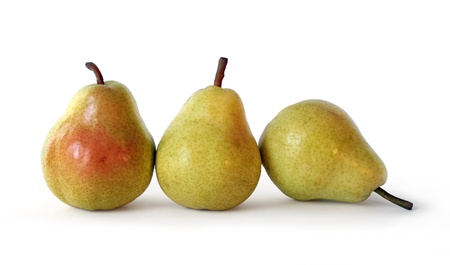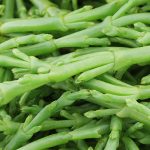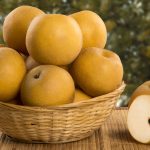
History
The genus is believed to have originated in Western China, in the foothills of Tian Shan which is a mountain range of Central Asia. The genus is known as Pyrus and there are a number of species in this group but P. communis appears to be the species from which most cultivated pears are derived.
The fruit tree appears to have spread north and south along those mountain chains that fan out from the central Asian location. The pear then evolved into diverse group of over 20 widely known primary species although there are still some being reclassified as subspecies. The enormous variety of cultivated European pear is considered to come from one or two wild subspecies, namely P. communis subsp. caucasica and P. communis subsp. pyraster which are still distributed widely throughout Europe and also form part of the forest and woodland cover. An Asian species having medium to large edible fruits includes the species, P. ussuriensis, P. pyrifolia, P. × sinkiangensis, P. × bretschneideri and P. pashia. Other species of small fruited types are used as rootstocks for cultivated forms.
The European pear which we now cultivate and grow in our orchards is considered to be a series of crosses of two subspecies of wild pears, P. communis subsp. caucasica and P. communis subsp. pyraster. These are now unable to cross with our domesticated pears. These pears were collected from the wild trees long before they were introduced into general cultivation. The remains of pears have been found at sites throughout the Bronze age and in Neolithic Europe. They have been grown as a basic fruit from earliest prehistory and the term pear is found throughout the Celtic speaking peoples. Indeed, traces of the fruit have been found in prehistoric lakeside dwellings around Lake Zurich. In China, pears have also been cultivated for nearly 3,000 years where they have also been consumed in both savoury and dessert dishes.
Pears grow well in cool temperate climates. They are now found cultivated throughout most of Northern Europe and North America. Other small fruited pears are distinguished by their early ripening and apple-like fruit. These are derived from the P. cordata species which grows wild in Western France as well as South-Western England.
The Roman and Greek writers such as Cato the Elder, Theophrastus and Pliny the Elder discussed cultivation as well as the grafting of pears onto other wood stocks to reduce tree height, increase fruit yield and improve viability. The Romans cultivated pears to eat or bake alongside both cooked and raw apples. The Roman cookbook, De Re Coquinaria provides a recipe for stewed, spiced pear patina which is a type of soufflé.
The pears with a white down on the undersurface of their leaves probably originated from a pear species P. nivalis and its rather more bitter tasting fruit is now used in the UK and France for manufacturing a type of alcoholic cider called perry. A number of perry varieties as well cider apple varieties also grow in the county of Monmouthshire as well as Somerset in the UK. The former county has long been associated with perry and as an alcoholic beverage. It was often drunk alongside apple cider. At times, cider and perry making were considered the drink of the people whilst beer which also developed at a similar time was brewed by the monks of various abbeys. There was quite a great deal of conflict between people and church over this aspects because of the loss of revenue to the church.
We discuss the current cultivation and growing of pears in a separate article.



Leave a Reply